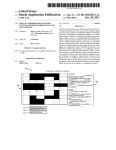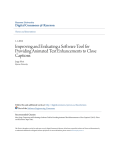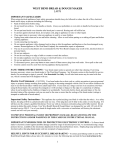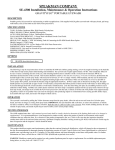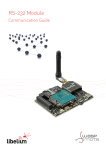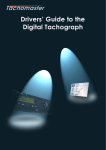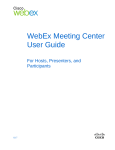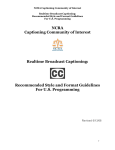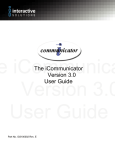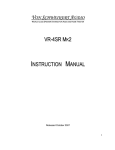Download A Guide to Working With Deaf and Hard of Hearing Students
Transcript
f a e D h it W g n i ork ing r W a e o t H of d r Guide a ts H n e d and u t S Secondary & Postsecondary Educational Setting Vocational Employment Setting PEPNet, a collaboration of four regional centers: California State University at Northridge, Rochester Institute of Technology-National Technical Institute for the Deaf, Saint Paul College-A Community & Technical College, and University of Tennessee, Knoxville is supported by cooperative agreements with the U.S. Department of Education, Office of Special Education Programs. This resource was developed in a previous project cycle when the four PEPNet regional centers were known as the Midwest Center for Postsecondary Outreach (MCPO), the Northeast Technical Assistance Center (NETAC), the Postsecondary Education Consortium (PEC), and the Western Region Outreach Center & Consortia (WROCC). During the current funding cycle (2006-2011), the four regional centers are collaborating on resource development. The regional centers have been renamed to reflect their region and affiliation with PEPNet: PEPNet-Midwest, PEPNet-Northeast, PEPNet-South, and PEPNet-West. Older materials from the previous project cycles will be updated when necessary. Release date: 2009. Postsecondary Education Programs Network (PEPNet) www.pepnet.org Guide to Working With Deaf and Hard of Hearing Students Secondary & Postsecondary Educational Setting Vocational Employment Setting Western Region Outreach Center & Consortia At The National Center on Deafness California State University, Northridge 18111 Nordhoff Street Northridge, CA 91330-8267 888.684.4695 V/TTY Toll Free http://wrocc.csun.edu/ Table of Contents Introduction 1 A Synopsis of Deafness 2 Successful Communication 7 Post Secondary Education 9 Secondary Education 12 Vocational Employment Setting 14 Conclusion 16 Appendix I A Professor Shares His Experience 17 Appendix II A Vocational Rehabilitation Counselor Shares Her Experience 19 Appendix III Glossary 23 II Introduction T he Western Region Outreach Center & Consortia (WROCC) created this booklet with the goal of educating professionals who will be working closely with deaf or hard of hearing students in a school or employment setting. WROCC aims to increase and enhance postsecondary educational opportunities and employment for deaf and hard of hearing individuals. For further information, please visit WROCC's website at http://wrocc.csun.edu. Through a regional and national network with the Postsecondary Education Programs Network (PEPNet), WROCC also serves as the repository for materials developed by other centers. These materials are housed in the PEPNet Resource Center (PRC) and are available at little or no cost. Visit our website at http://prc.csun.edu to see the entire collection of products available. Funded through a five year cooperative agreement with the Department of Education, WROCC resides at the National Center on Deafness at California State University, Northridge. 1 A Synopsis of Deafness H earing loss affects more than 28 million people in the United States today. With the passing of the American with Disabilities Act (ADA) law in 1990, an increased number of deaf and hard of hearing students are seen attending community colleges and universities, and looking for jobs. Chances are you will end up with a deaf or hard of hearing individual in your classroom or work place. Will he or she be able to understand you? As the philosopher Heraclitus proclaimed, "Knowing doesn't reach understanding." More important than knowing any single term about deafness is the understanding that deaf people are people. They are more like you than they are unlike you. Their deafness is only one facet of their multidimensional characters. Each deaf person is as unique as you are. A deaf or hard of hearing person develops communication abilities according to their upbringing and various influences. Deafness, also known as the invisible disability, often goes undetected for an extended period of time. As a result, these children must learn, rather than acquire, their first language. Ways of communicating vary among these individuals and there is no right or wrong way. Some will use speech only; some will use a combination of sign language, fingerspelling, and speech; some will write; some will use 2 body language and facial expressions to supplement their interactions. The important thing to remember is one deaf person's communication method does NOT represent the entire deaf population. What does it mean to be hard of hearing? A person may be able to hear some individuals better than others, because the speaker's voice is generally outside the frequencies where the individual's hearing loss occurs. Whether a person has a significant hearing loss or a mild one, their dependence on acquiring and understanding sounds depends on the environment, the speaker, and the level of training received. Hearing Aids and Cochlear Implants Don't hearing aids and cochlear implants remedy the loss? Most hearing aids amplify a range of sounds specific to the individual's hearing loss. If a person has a loss in high frequencies but not the lower ones, most hearing aids will amplify only the high frequencies. Cochlear implants, on the other hand, are designed to by-pass cochlear hair cells that are non-functioning and provide direct stimulation to the auditory nerve. Unfortunately, neither hearing aids nor cochlear implants discriminate between speech and background noise. Do not assume a hard of hearing or deaf person with hearing aids is getting the complete information. A common example is when students are packing their books to leave class and the teacher announces a room change for the next class. Between looking down to pack books together and room noise, the student will not know the announcement has been made. 3 Lip Reading (or Speech Reading) Lip reading is a skill that many deaf and hard of hearing individuals develop. These people will say, "If I can't see you, then I can't hear you." Nonetheless, only 33% of English speech sounds are visible on the mouth. Thus, lip reading involves using residual hearing, watching body language and facial expressions, and knowledge of the topic to correctly fill in the blanks. Not everyone will be able to lip read in the language-dense environment. A skilled lip reader will not be able to follow group discussions or instruction that is given while the instructor is looking down or has his back to the class. Students who lip read must concentrate intensely in order to acquire information. Brief breaks during the day help them release energy and/or relax. Communication Suggestions When Face to Face With a Deaf Person Listed below are a few specific techniques that can help those who do not know how to communicate in sign language. Get the deaf/hard of hearing person's attention before speaking. Since deaf and hard of hearing people can not hear the usual call to attention, they may need a tap on the shoulder, a wave, or other visual signal. Speak slowly and clearly. Exaggeration and overemphasis of words distorts lip movements, making lipreading more difficult. Look directly at the person when you speak. Even a slight turn of your head 4 can obscure the deaf/hard of hearing person's view. Other distracting factors affecting communication include mustaches covering the lips, putting your hands in front of your face and habits such as smoking, and pencil chewing. Maintain eye contact. Do not be embarrassed about using paper and pencil or a computer if it is convenient. Getting the message across is more important than the medium used. If you are having difficulty getting an idea across, try to rephrase a thought, or restate a sentence rather than repeating exactly the same words. Sometimes a particular group of lip movements is difficult to lip read. Use pantomime, body language, and facial expression to facilitate communication. Try to avoid standing in front of a light source such as a window. The bright background and silhouette created on the face make it almost impossible to lip read or focus on the interpreter. Use E-mail: Many individuals who are deaf or hard of hearing appreciate getting e-mail messages instead of phone calls because it does not involve relying on a third party to translate the conversation. Instant Messaging: An increased number of deaf students are turning to instant messaging for quick conversations with professors, teachers and vocational counselors. Office meetings are not always possible if a student is unable to get an interpreter to facilitate communication. Emails can be slow. Instant messaging is quick, allows communication to flow smoothly, and eliminates all communication barriers. 5 Internet Relay Service: Internet relay is a 24-hour service that allows individuals who are deaf, hard of hearing, or speech disabled to use computers to connect to relay service via the internet and place a call to the other party. Telecommunications Relay Service: The Federal Communications Commission (FCC) reserved 711 for Telecommunications Relay Service in each state. Deaf and hard of hearing people can dial 711 and make TTY to Voice, Voice to TTY, two-line Voice Carry Over, and Hearing Carry Over calls. Video Relay Service: Video relay service (VRS) enables American Sign Language (ASL) users to communicate via videoconferencing. Using a telephone and web camera, an interpreter sits remotely between a sign language user and a standard telephone user to help facilitate the converstations. Text pagers: Another resource may be the use of text pagers. In short, these text pagers can serve much like a cell phone does for an individual who can hear. If the setting or site requires distance or independence between you and your trainee or employee, a text pager may be just the answer. By putting the text pager on "vibrate" mode, an individual who is deaf or hard of hearing may be alerted to your text message and reply accordingly by using the miniature keyboard on the text pager. This is an answer to access that many have found helpful in these settings. 6 Successful Communication T he key to conveying valuable information to deaf and hard of hearing students or clients is working with service providers or utilizing other creative resources and technology that will provide successful communication. Working with service providers does not need to be a daunting task and won’t be once you understand what is involved. Utilizing modern technology can also be very beneficial when the need to talk with a deaf individual arises. Sign Language Interpreters: The interpreter is not the student's peer, but an adult in a professional role. Interpreters facilitate communication between deaf/hard of hearing and hearing individuals by conveying all auditory and signed information so that individuals may fully interact. Interpreting may be done manually (using American Sign Language) or orally. Instructors should refrain from asking the interpreter to perform other tasks as it may interfere with the quality of communication provided and compromise the role of the interpreter. In other words, the interpreter should not participate in class. Some ground rules include: 1. If the instructor or fellow students want to speak with the deaf or hard of hearing student they should talk directly to the student and not to the interpreter. 2. Give the interpreter copies of all handouts and, if possible, copies of all textbooks before class. 7 3. The instructor may want to set up a system in the classroom where only one student speaks at a time. 4. The instructor should be aware of his or her own rate of speech. It may be necessary to slow down and include more pauses. 5. The interpreter should not be thought of as a participant in class. They do not perform tasks. 6. The interpreter is to interpret all information that is transmitted, including private but audible comments and environmental sounds. 7. The lighting of the room where the interpreting is occurring should be adjusted in such a way as to not create shadows or glare for the deaf or hard of hearing students. 8. Whenever visual aids or demonstration will be used, allow time for a visual shift from the interpreter to the visual aid. 9. Captioned films and videotapes are strongly recommended to allow the student direct visual access to information. Captionists: Captionists take the instant transcription of the spoken word and change it to the English text using a stenotype machine, laptop computer or real-time software. The text is then displayed on a computer monitor or other display device for the student who is deaf or hard of hearing to read. 8 Notetakers: Notetakers provide a written source of information after a class lecture. Notetakers are important because the student with a hearing loss will have his or her eyes occupied while watching an interpreter or the captionist, thus impeding their ability to take notes. Assistive Listening Devices (ALD): Ideal in a classroom setting, a small microphone with a transmitter is worn by the instructor to increase volume and clarity of class lectures. The student wears the receiver. Postsecondary Education O n the postsecondary level, the responsibility lies with the student to request support services. When the student presents documentation identifying their needs, and ideally the recommended accommodation, it is then the responsibility of the college or university to provide what is needed. This is based on Section 504 of the Rehabilitation Act of 1973 (P.L. 93-112), together with the implementing regulations of 1977, which prohibit discrimination solely on the basis of handicap. The regulations apply to postsecondary education, training, and employment programs that receive federal funds in the form of student aid, research grants, and other programs. The Americans with Disabilities Act of 1990 has further strengthened the provision of support services to students with disabilities and the responsibility postsecondary institutions have in meeting the needs of students with disabilities who apply for admission and accommodation. 9 Where to Go for Information Most postsecondary campuses have a disability center that provides assistance to deaf and hard of hearing college students. Few colleges have a direct deaf service program. If your campus does not, chances are students are getting assistance through the disability support services office. Interpreters' Roles in a College Setting Following the general rule of thumb, postsecondary interpreters heed their code of ethics and transmit everything that is said in exactly the same way it was intended. This is especially important at the college level. Language and words professors use in lectures are often the same language and words used on upcoming tests and finals. If requested, students wanting information transmitted only in American Sign Language (ASL) will have their needs met. Unlike K-12 grade levels, interpreters do not play dual roles in the classroom but, abiding strict confidentiality, accept only assignments for which they are qualified. At the college level, if the deaf student(s) is not present when class begins, the interpreter may wait a few minutes outside of the classroom. After ten minutes, the interpreter may leave to cover another assignment with a deaf student in need of interpreting services. In case of interpreter absence, your student can recruit a volunteer notetaker from your class and he or she may ask you for additional notes missed in class. 10 Professor Responsibility Having a student who is deaf or hard of hearing in the classroom often is a new and challenging experience for a professor. As a professor, he or she is the 'head of the class,' simply meaning, the one who sets the pace, tone, and atmosphere for learning. It is no small feat, yet one that is easily overlooked. Aside from the usual classroom preparations, the professor must enforce the disciplinary code that is expected in the classroom. Each student in the classroom falls under the jurisdiction of the professor, each having individual responsibilities to ensure success. These responsibilities fall to every student, regardless of whether they have a disability. A professor has a job to do in the classroom, as does the student. Some specific tips that may be useful for professors teaching students who are deaf or hard of hearing are mentioned in "A Professor Shares His Experiences" at the end of the booklet. Testing Accommodations Testing time may be extended to limits of time and a half, double time or unlimited. This should be determined by the student, disability suport services counselor, and instructor ahead of time. Interpreted tests may be necessary for some students who have difficulty reading English. This is usually used when English comprehension and expression are not being tested. Distraction-free testing is determined by student, counselor, and instructor. This can be arranged with prior notification. 11 Secondary Education T he path to a successful postsecondary education or career begins in high school where suddenly every class taken and every grade received is recorded and filed for future refernce. To ensure that all deaf students have equal access to the same education hearing students are receiving, laws and programs, such as those explained below, have been implemented. IDEA The Individuals with Disabilities Education Act (IDEA) requires certain information to be included in each child's IEP. It is useful to know that states and local school systems often include additional information in IEPs to document that they have met certain aspects of federal or state laws. The flexibility that states and school systems have to design their own IEP forms is one reason why IEP forms may look different from school system to school system or state to state. Yet each IEP is critical in the education of each child. IEP There are various programs designed to meet the challenges of educating a deaf or hard of hearing child. The critical point to determine a particular child's educational program begins with the Individualized Education Plan (IEP) which provides for an appropriate education. The IEP gives educators and parents a way to custom-tailor instruction to the students' needs, thereby broadening his or her educational opportunities. 12 The IEP is a federally required document that lists all services the child is to receive, as well as measurable goals and objectives to be achieved during the academic year. Beginning at age 14, the student's IEP must address the steps he or she needs to take to reach post-high school goals. A statement of transition services needs must be included in each of the student's subsequent IEPs. Additional Rights Students have a right to participate in non-academic activities, athletics, and clubs. Schools do not have the option to prioritize academic needs and deny services for extra-curricular activities. The IEP team determines what accommodations students may need to participate in these extra-curricular activities then follow through with making sure services are provided. Interpreters' Role for K-12 The role of a sign language interpreter in a K-12 setting may differ from a university or community college interpreter. Additional responsibilities are often added to the interpreter's role. This includes: 1. Share information about a student with the educational team, with appropriate considerations for confidentiality 2. Clarify information for the student when necessary 3. Help the student learn how to use an interpreter 4. Interpret all content areas according to the student's IEP 13 Vocational Employment Setting V ocational employment offices generally do not have a Deaf Services or Disabled Services office. Sometimes there is one deaf, hard of hearing or signing employee in these settings, ready to provide resources necessary to ensure deaf and hard of hearing clients' placement at jobs or school. It is essential in remembering the importance of involving deaf or hard of hearing clients' perspectives when making decisions on work placement and job environment. Accommodations will differ according to the placement. Communication needs for each individual are unique and should not be assumed relevant to all other clients. Accommodations necessary for training in a dental lab school greatly differ from a secretarial position. You won't find a prospective secretary needing visual guidelines on learning to type faster. You will find a prospective dental hygienist needing visual, step by step guidance on creating crown molds. Likewise, truck driving school and computer programming would require specific accommodations to equalize the environment for deaf and hard of hearing clients and employee training. The types of support services and technology available to individuals in vocational education, training, or employment setting are plentiful and clients should always be asked what best fits their educational needs. Remedial Deaf Clients: When working with remedial deaf individuals the situation becomes more challenging. Remedial deaf clients have 14 learning disabilities or low cognitive functioning, which may render traditional services, useless. A typical sign language interpreter or the ALD device may not provide appropriate communication access and can aggravate the remedial deaf client further. Deaf clients with certain learning disabilities or deficit cognitive functions may have effective results with Certified Deaf Interpreters and/or Job Coaches. Certified Deaf Interpreters: The Registry of Interpreters for the Deaf (RID) defines a Certified Deaf Interpreter (CDI) as "an individual who is deaf or hard of hearing and has been certified by the Registry of Interpreters for the Deaf as an interpreter." These Deaf interpreters use many skills when communicating information to the Deaf consumer. A CDI needs additional expertise to what one may receive from a hearing or traditional interpreter. They may have specialized training in the use of gesture, mime, props, drawings, and other tools to enhance communication. Job Coaches: Job Coaches may be helpful in vocational rehabilitation training and employment settings. The Case Service Manual used by most Vocational Rehabilitation counselors details the use of Job Coaches and when they are an appropriate accommodation for deaf and hard of hearing clients. This is referred to in the Case Service Manual as Supported Employment and Supported Job-Based Training. There are three categories of service: A. Pre-placement and Extended Services B. On-site training and support C. Off-site support 15 All services are intended to be for work-related activities that will enable a Vocational Rehabilitation eligible client to obtain or maintain employment. Some of the services that Job Coaches may provide include meeting with the client's rehabilitation counselor or others and reviewing assessment information, job matching, job applications, job interviews, and orientation to the job site. During the job skill training phase of the placement, a job coach may be involved in the following processes: Intensive, on-the-job training needed to achieve and maintain job stability, re- training for any changes that occur after the job coach has phased out as requested by the employer, and on and off-site monitoring of an individual or group of workers. Job Coaches may also be client advocates. Advocacy may be in the form of advising or discussing with the employee any aspect of obtaining and maintaining employment and resolving problems at work. Also advocacy may be discussing work or personal issues with employers, parents, case managers, and counselors. Conclusion I t is important that colleges, universities, secondary institutions, and vocational rehabilitation develop a working relationship with other agencies to promote effective and accessible services to students. Vocational rehabilitation has long been involved in the provision of funding for students' needs while attending a postsecondary institution. 16 However, an ADA ruling has made colleges and universities responsible for the cost of services. This means that vocational rehabilitation is not responsible for paying for interpreters, notetakers, or captionists. The responsibility lies with the institution. Furthermore, it is the responsibility of secondary institutions to supply deaf and hard of hearing students with self-advocacy skills and knowledge of their rights, to prepare them for college and beyond. A Professor Shares His Experiences D r. Mark Schilling, a math professor at California State University, Northridge, talked about his experience teaching deaf and hard of hearing students. How did you feel the first time you had deaf and hard of hearing students in your class? It seemed a bit unusual at first, but had no great effect on me or my teaching style. What sort of changes have you made? I provide the interpreter with a glossary of technical terms so that they and the students can work out signs for them rather than having to painstakingly spell them out. I am also more careful to write things down on the board. I make sure that the students and interpreter are well located and that I am not in their way. I make sure not to speak too quickly. I also ensure that deaf students are full participants in the class. In classes where I call on students, I call on deaf and hearing students with equal frequency. Is the interpreter a big help to the student? 17 Appendix I Essential. It is particularly useful to have an interpreter who knows something about the subject. On those rare occasions when the interpreter is not there it is a disaster. The deaf students usually just leave. Isn't it distracting? Don't the hearing students watch the interpreter instead of you? It is not at all distracting for me. My sense is that hearing students take it quite in stride. What else does the interpreter do to help you? Serve as an interface when we are doing activity based learning or when a deaf student wants to ask me a question before or after class. How do the deaf and hard of hearing students do? On average, somewhat lower than hearing students. However, I have learned that, as with hearing students, there is wide variability in both effort and ability. Consequently there is a large overlap in performance between the two groups. I have had several deaf students who were among the very best students in the class. What do you do if the deaf students don't do well? I try to provide gentle encouragement. Also, I mention tutoring as a valuable resource. Don't many deaf students have problems with Math? How does that affect your class? I don't see any more problems with math background than with hearing students. What is difficult is when we are using the computer to support concepts that I am explaining and also illustrating on the board, there are too many places for the deaf students to look. Deaf students seem to struggle more with use of the computer-perhaps for this reason. ���������� 18 How do you feel about teaching deaf students now that you have done it for a while? I am quite comfortable with it and feel good that I can help many of them achieve successful outcomes. I would like to stress to such students that (1) all students will need to work very hard to be successful in Math, especially in reading the textbook carefully to the point of understanding, and (2) have confidence in your abilities. Insecurity often leads to a defeatist attitude, which leads to failure. Nearly everyone who works hard and is willing to think carefully about things can succeed in the courses that I teach. * Schillings, M. (2004) Interview with a Professor at California State University, Northridge. A Vocational Rehabilitation Counselor for the Deaf Shares Her Experiences J oy Roberts, MS, CRC (Certified Rehabilitation Counselor) at Utah State Office of Rehabilitation shares her experiences working with individuals who are Deaf and Hard of Hearing. The following excerpts from an interview may prove helpful in Vocational Rehabilitation education and employment settings. What special considerations should one take when working with an individual who is deaf? 19 Appendix II I have noticed that sometimes in the Vocational Rehabilitation system, hearing loss is misunderstood. It is important to become educated about the issues secondary to hearing loss so that appropriate placement and assessments are performed. Also advocating for our population and encouraging self-advocacy by the client is vital to success. What are some barriers faced in Vocational Rehabilitation settings when working with clients who are deaf and hard of hearing? Preparing a client for a job versus a profession can be a barrier at times. Individuals who are deaf who do not experience "academic success" are often a misnomer. It is mismeasured. For example, deaf clients sometimes have barriers due to a lack of English language development and they should not be penalized for this lack of language development. They should be worked with in the system to help them achieve the academic success that will come. Also, once an individual who is deaf or hard of hearing is successfully prepared for a profession versus a job, there are still barriers to overcome. The old mindsets and stigmas of "deaf and dumb" still exist in our culture today. We must overcome these mindsets with employers, schools, counselors and the clients themselves. We are looking for training and eventual employment that fits the person's abilities and desires. We must help clients accomplish those goals. How do you overcome some of those barriers? Sometimes you have to overcome barriers legally. In the past there wasn't Appendix II 20 legal support (prior to the Americans with Disabilities Act), but in our age of the ADA and Disability Law Centers, sometimes you need to enlist that help and support. We also need to educate employers and training to understand the impediments to employment. For example, if a person came in with one leg, we would not tell them that they are ok, and they have no disability nor need accommodations. However, I have noticed with clients who are hard of hearing sometimes, they face being told, that hearing with one ear is good enough, and it shouldn't be a problem or impediment in education, training, or work! We again, need to educate, advocate, and work on mindsets, myths, and old ideas. We need to promote and provide appropriate accommodations in all of these settings. Are interpreters helpful in Vocational Rehabilitation settings? Absolutely! Often our challenge now is the issue of qualified interpreters especially in rural areas where there is an extreme shortage of qualified interpreters. So, in those situations, we need to be more creative in providing those services. What advice would you give to someone needing to use a Job Coach? Make sure you get a job coach who can sign! If their signing skills are not up to par, the perception of the person who is deaf that the coach gives to the employer is worse and does not reflect the deaf person! The job coach may be put in the position of having to function as an interpreter; this can create a problem if they do not have the skill to function in that position. I have 21 Appendix II made an effort in those cases to make sure that "lines are drawn" at the beginning. A meeting with a job coach, the employer, and the client at the start of the interaction, can be helpful to define roles and establish rules of engagement throughout the process. What help are Assistive Listening Devices (ALD's) in Vocational Rehabilitation settings? Hearing aids are the most often used assistive listening device in these settings in my experience. Often there are concerns in the work environment about safety issues of a machine crashing, people yelling a warning, etc. A hearing aid can alert many people with residual hearing to these concerns. Also, some colleges are now building into their new buildings access to FM systems for those who are hard of hearing. Public meetings and buildings are now much more accessible with these technologies. In training settings what is the best advice you could give to encourage the success of the client? I would educate, empower, and prepare the client to do their own thing! We do direct referrals to the Disability Resource Centers (DRC) now to tell them the client is coming, and then the client does their own contact and work with the DRC. What is the best advice you could give to encourage success of the provider of the training? Appendix II 22 I would suggest that providers interface with other providers who are doing similar things. I often refer DRC's to other DRC's to get ideas. I would encourage a resourceful look at possibilities of what you can do versus saying, "I cannot do it." Be creative in providing those services! * Roberts, J. (2003) Interview with a Vocational Rehabilitation Counselor for the Deaf. Glossary Understanding the Jargon There are many specialized terms related to the field of deafness. A few expressions used frequently and often misunderstood or misused include the following: Adventitious Deafness: Deafness occurring sometime after birth. Cochlear Implant: An auditory prosthesis consisting of an electrode array that is surgically inserted into the cochlea. It runs off an external processor, providing access to sound. Not all individuals are considered for cochlear implantation. Cochlear implants do NOT restore hearing to normal. Congenital Deafness: Deafness occurring at birth. 23 Appendix III Deaf-mute or Deaf and Dumb: Outdated terms used to describe a person with a hearing loss, and generally considered offensive today. The terms are technically incorrect because the vast majority of individuals who have a hearing loss are not physiologically dumb (mute.) Instead, use “Deaf” or “hard of hearing.” Hard of Hearing: A condition where the sense of hearing is defective but retains some functionality, depending on the listening environment, usually with the help of a hearing aid. Prelingual Deafness: Deafness occurring before the acquisition of language, usually before three years of age. Such a person has no language frame of reference when learning to speak, write, or speechread. Postingual Deafness: Deafness occurring after the acquisition of language, usually after three years of age. In most cases, persons who have lost their hearing after this age have a relatively strong language base. Residual Hearing: The amount of hearing a person has; the ability to understand speech varies with the residual hearing or the individual. Getting the Communication Terms Straight American Sign Language (ASL): A natural visual-gestural language with syntax, structure, and grammar rules different from English. Conceptually Accurate Signed English (CASE): A combination of ASL and English which maintains the use of traditional ASL signs and follows English word order. Appendix III 24 Deaf Culture: The way in which many members of the Deaf Community view themselves, within hearing society but separate from hearing culture. Deaf culture can be delineated by technology, social customs, or simply by being other than a hearing person. Membership in the Deaf culture is a source of pride for many deaf people. Fingerspelling: Words spelled out in finger configurations which represent individual letters of the English alphabet. Hearing Aid: An electronic device that amplifies sound and is usually individually fitted to a deaf or hard of hearing person. For those with little residual hearing, it may only assist in the awareness of sound. For others, it may assist in the understanding of speech. While many deaf or hard of hearing individuals benefit from wearing aids, some do not. Interpreter: Interpreters are trained professionals who transmit every part of the message exactly in the way it was intended. Interpreters follow a strict code of ethics that binds them to confidentiality and prevent their becoming personally involved in an interaction. Notetaker: Some notetakers are hired by the university while others are students who volunteer to take notes in their classes. Some notetakers receive special training to take clear, concise notes in the classroom. Notes include lecture information, diagrams, and notes from the class, and threads of class discussions. 25 Appendix III Oral Interpreter: An interpreter who may or may not sign, but who concentrates on the spoken message by clearly mouthing the message for consumers who prefer to lip-read. Oral interpreters are professionally trained and are bound by the same code of ethics as are other interpreters. Real-time Captioning: Combination of stenographic and personal computer technology and allows a real-time stenographer to convert a classroom lecture into a text-based medium as it occurs. This communication service is preferable to students who are not proficient signers. The notes are saved on a laptop computer and may be printed for the student's reference. Speechreading (also known as lip-reading): The process of watching a person's mouth movements and facial expressions to ascertain meaning. At best, speechreading can be considered an art. Research has shown that approximately two-thirds of English speech sounds do not appear on the lips. Simultaneous Communication: The combined use of speech, signs, and fingerspelling. Because the two languages are unique, the resulting expressive language is necessarily imperfect, a pidgin form combining the grammar of both languages. 26 Appendix III 26 27



































